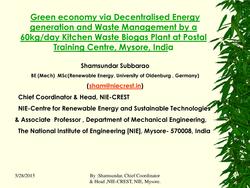Difference between revisions of "Decentralized Energy Generation and Waste Management in India"
From energypedia
***** (***** | *****) m |
***** (***** | *****) m |
||
| Line 1: | Line 1: | ||
[[File:Banner MES 2015.jpg|center|800px|Micro Perspectives for Decentralized Energy Supply - Documentation|link=Micro Perspectives for Decentralized Energy Supply - Documentation 2015]] | [[File:Banner MES 2015.jpg|center|800px|Micro Perspectives for Decentralized Energy Supply - Documentation|link=Micro Perspectives for Decentralized Energy Supply - Documentation 2015]] | ||
| − | |||
{| border="0" cellspacing="3" cellpadding="0" align="center" style="font-size: 14px; width: 805px;" | {| border="0" cellspacing="3" cellpadding="0" align="center" style="font-size: 14px; width: 805px;" | ||
|- | |- | ||
| Line 8: | Line 7: | ||
| style="width: 175px; text-align: center; vertical-align: middle; background-color: rgb(139, 45, 45);" | [[File:MES Impressions Icon.png|center|100px|Impressions|link=Micro Perspectives for Decentralized Energy Supply - Impressions 2015]] | | style="width: 175px; text-align: center; vertical-align: middle; background-color: rgb(139, 45, 45);" | [[File:MES Impressions Icon.png|center|100px|Impressions|link=Micro Perspectives for Decentralized Energy Supply - Impressions 2015]] | ||
|} | |} | ||
| − | + | ||
= Decentralized Energy Generation and Waste Management in India = | = Decentralized Energy Generation and Waste Management in India = | ||
| Line 17: | Line 16: | ||
{| border="0" cellspacing="3" cellpadding="5" style="width: 800px;" | {| border="0" cellspacing="3" cellpadding="5" style="width: 800px;" | ||
|- | |- | ||
| − | | | + | | The 60 kg/day Kitchen waste biogas plant at Postal Training Centre [PTC], Mysore, India implemented by NIE-CREST has solved the problems of waste disposal and created a value chain of waste to energy. The plant at present is partially fulfilling thermal energy demand, has achieved zero waste and low carbon footprint. Analysis of 60 days data shows generation of 251.65 m of biogas (100.66 kg LPG Eq.) from 2600 kg of waste amounting to INR. 9831.97 averaging to biogas generation of 0.097 m3/kg of waste and an average feed of 43.33 kg/day. The plant in a year saves |
| − | + | 611.74 kg of LPG, reduces 1.85 tonnes of CO2 emission, converts15.82 tonnes of waste to energy & organic manure thus contributing to green economy. Further COD reduction of 74.7 %, BOD | |
| + | reduction of 80.9 % was achieved in outlet slurry | ||
| + | | [[File:Decentralized Energy Generation and Waste Management in India.pdf|250px|border|Decentralized Energy Generation and Waste Management in India.pdf]] | ||
|} | |} | ||
| − | |||
| − | |||
= References<br/> = | = References<br/> = | ||
| Line 28: | Line 27: | ||
__NOEDITSECTION__ __NOTOC__ __NOTITLE__ | __NOEDITSECTION__ __NOTOC__ __NOTITLE__ | ||
| + | [[Category:Conference_Documentation]] | ||
[[Category:Microenergy_Systems]] | [[Category:Microenergy_Systems]] | ||
| − | |||
Revision as of 10:03, 10 June 2015
Decentralized Energy Generation and Waste Management in India
Presenter: Shamsundar Subbarao (University of Oldenburg ,Germany)
Presentation
References
Shamsundar Subbarao: Micro Perspective for Decentralized Energy (MES) 2015, Bangalore, India.





















